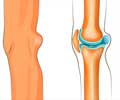A 100 kg Iraqi woman underwent a rare bilateral total knee replacement successfully in Delhi's Vimhans Nayati Super Specialty Hospital.

‘A 65-year-old Iraqi woman who had a high BMI was suffering from difficulty in walking and severe back pain. After a rare bilateral total knee replacement both her legs are straight with full movement of knee joints.’
Read More..




According to the hospital authorities, she was diagnosed with advanced osteoarthritis (Stage 4), wherein patients experience pain and discomfort in moving their joints, preventing or hampering daily activities. Read More..
"Due to bad deformity of knee joints, joint laxity, and weak bones, the patient was suffering painful knees for the past 15-20 years. In this case, excess weight exerted extra pressure on her hips and knees, causing faster deterioration of the joint cartilage. She could not walk or stand for more than five minutes," said Dr. Rajeev Kumar Sharma, Chairman, Institute of Orthopaedics, Sports Medicine and Arthroplasty, Vimhans Nayati Super Specialty.
The medical experts noted that with each BMI unit increase, the chances of rapid cartilage loss rise by 11 percent. The patient also had comorbid symptoms such as diabetes and hypertension. As the high BMI makes the procedure strenuous for anesthesia and surgery, it was done in multiple sessions.
"Since the patient was in Class 3 (high-risk) obese category, her obesity made it a rare case. With such high BMI, total knee arthroplasty is almost impossible for the patient to endure any safe surgical procedure in routine circumstances. Besides, weak bones made the fixation of implants unmanageable," Dr. Sharma added.
To ensure the benefits of this surgery last longer, backed by an improved range of motion, the medical experts used a mobile-bearing joint that can last up to 20-25 years.
Advertisement
Source-IANS













